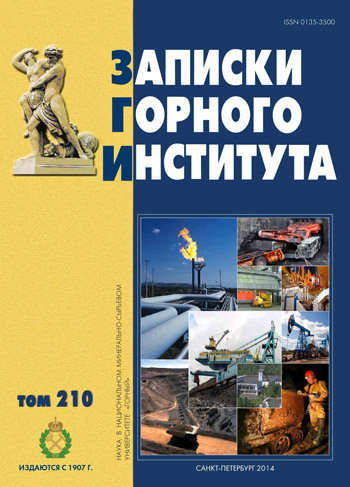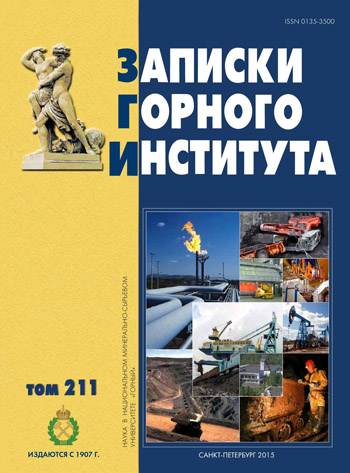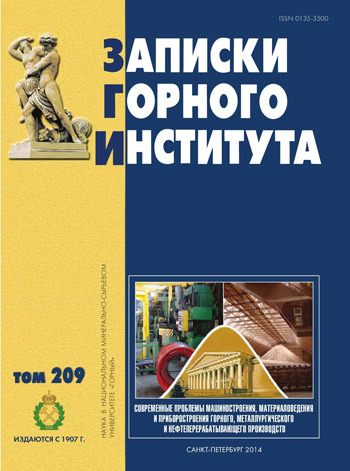-
Date submitted2014-06-24
-
Date accepted2014-08-31
-
Date published2014-12-22
Unique engineering and technology for drilling boreholes in Antarctic ice
- Authors:
- Vladimir S. Litvinenko
As the result of many years of research into the processes of the transfer of ice as a rock mass on a global scale, concerning the Antarctic ice sheet at the ultra-deep 5G borehole, a discovery has been made that is of international significance in the areas of glaciology and geodynamics. Those who created the theory of thermal and mechanical penetration into ice and loose sediments have developed unique technology and engineering processes in order to drill boreholes using thermal and mechanical methods.
-
Date submitted2014-06-23
-
Date accepted2014-08-27
-
Date published2014-12-22
Theoretical aspects of the kinetics of gas hydrates
- Authors:
- E. P. Zaporozhets
- N. A. Shostak
In the systems of collection, preparation, transportation and processing of hydrocarbons in conditions of a certain temperature and pressure, gas hydrates, which adversely affect the operation of the processing equipment, are formed. To prevent hydrate formation, it is necessary to determine the time and rate of growth. For this purpose, physical and mathematical models describing the growth of crystalline hydrates are being designed and developed. The developed models differ from one other. The reason for the difference is that each model is designed for specific temperature and pressure conditions and individual gas hydrates (or mixtures). The main theoretical models describing the process of growth of hydrates under different conditions are presented.
-
Date submitted2014-07-14
-
Date accepted2014-08-29
-
Date published2014-12-22
The development of ideas for improving explosive destruction of rock masses – the basis of progress in mining
- Authors:
- S. D. Viktorov
- V. M. Zakalinskii
The article describes the main areas of research in the field of the explosive destruction of rocks used in mining. The results of studies carried out in recent years are presented. Information on possi-ble applications for breaking up rocks of various energy sources is provided. Ideas are given on the possibility of raising the efficiency of explosives for mining rock by increasing the scale of the ex-plosive destruction. Information about the widespread adoption of these methods at Russia’s biggest iron ore companies is presented. Recent results on the fracture processes at different levels of scale up to destruction to form particles of submicron size are shown. Studying the structural transforma-tions of rock mass at the micro and macro features of allocation and distribution of energy in the charges of various designs allowed us to control the action of a new explosion by breaking up rock masses and the complex structure of multicomponent fields.
-
Date submitted2014-07-08
-
Date accepted2014-09-08
-
Date published2014-12-22
The development of methods for increasing the efficiency factor of gravitation extraction for fine and ultrafine gold from different genesis placers
- Authors:
- T. N. Aleksandrova
- V. B. Kuskov
The basis for and results of experimental studies for increasing the efficiency factor of gravitation extraction for fine and ultrafine gold from geogenic and man-made mineral formations with high clay content as well as alluvial placers are presented. The clayey gold-bearing placers of the Khabarovsk region in Russia’s Far East were used as the subject of research. These placers contain a substantial amount of fine particle gold and muddy material with hard washability, which are the main reasons for gold losses. One more object of research is a placer located in the Krasnoyarsk region, east Siberia. A special method of interpretation has been created for particle size distribution, using newly developed software which can increase the accu-racy of sedimentation analysis and predict the morphology of gold. It has been proved that one of the most promising ways in which to intensify the gravity processes can be effective preparation, including the chemical dispersion of gold dust before gravitational processing. Exploring the joint effect of sodium hexapolyphosphate and halogen oxidant on the efficiency of processing revealed that the combination of the peptization-coagulation cycles improves gold recovery. Also, the possibility of using concentration tables with various designs for production of rough concentrate is shown. The use of a new round disk concentrated table design enables metallurgi-cal results to be improved in comparison with shaking tables.
-
Date submitted2014-07-20
-
Date accepted2014-09-18
-
Date published2014-12-22
Use оf renewable energy sources in the coal industry
- Authors:
- A. V. Limanskii
- M. A. Vasileva
There are three fundamental basic documents in energy conservation and energy efficiency today: the Energy Strategy in the period up to 2030; the Federal Law «On energy-saving and energy efficiency and in amending particular legislative acts of the Russian Federation»; and the State Energy Conservation and Energy Efficiency Program in the period up to 2020. In recent years, the upward trend in the use of renewable energy sources (RES) is becoming all the more evident. Until recently, the development of energy has seen a clear pattern: the areas of energy which have developed most are those which have a quite fast direct economic effect. The social and environmental impacts associated with these areas were considered only as incidental, and their role in decision-making was negligible. With this approach, we considered RES only as a future energy source, when traditional energy sources have been exhausted, or when obtaining them becomes extremely expensive and timeconsuming. The primary driver behind the intensive development of RES has been public pressure based on environmental concerns, rather than economic calculations about the future. The economic potential of the world’s renewable energy is currently estimated at 20 billion tons of oil equivalent per year, which is twice the annual output of all fossil fuels. This fact shows us the path of energy development in the near future. In this paper, on the basis of the laws of the Russian Federation, renewable energy in the coal industry is considered. We describe the experience and prospects of the use of mine water and burning rock dumps.
-
Date submitted2014-07-09
-
Date accepted2014-08-31
-
Date published2014-12-22
Properties of electric arc furnace dust and methods of utilizing it
- Authors:
- M. A. Pashkevich
- T. A. Lytaeva
The least utilized recyclable wastes from mining and processing enterprises are dispersed wastes, which are in the form of dust captured by systems of gas purification. This dust is a technogenic raw material for the production of zinc and other metals. Various ways of utilizing the steelmaking dust are presented. For utilization of the steel-making dust, a hydrometallurgical method with the use of autoclave technologies is proposed. The results of experiments in sulfate autoclave leaching are described.
-
Date submitted2014-06-23
-
Date accepted2014-09-15
-
Date published2014-12-22
Topical issues of the management of extraction of underground waters on the territory of the Russian Federation
- Authors:
- N. V. Pashkevich
- E. I. Golovina
Water is a key component of our environment; it is a renewable, limited and vulnerable natural resource, which provides for the economic, social, and environmental well-being of the population. The modern system of taxation and regulation of subsoil use in the extraction of groundwater is currently imperfect and has definite disadvantages, among them not enough control of natural resources by the state, the commercialization stage of licensing, and the budget deficit, which is passed on to other areas of the national economy. General information about the state of the underground water supply in Russia, and the negative trends of underground water use are presented. The system of licensing underground water intakes in Germany is briefly described; some measures to improve the system of man-agement of Russia’s underground waters fund are suggested.
-
Date submitted2014-07-21
-
Date accepted2014-09-19
-
Date published2014-12-22
Preliminary preparation of oil for primary processing
Oil supplied for primary processing always undergoes preliminary preparation, the purpose of which is to eliminate the harmful effect of water and salt contained in the oil. It is thought that corrosion of the equipment is connected mainly with chlorides of magnesium and calcium, which are subjected to hydrolysis with the formation of hydrochloric acid. Under the influence of hydrochloric acid the destruction (corrosion) of metal equipment at technological plants occurs (especially refrigerating-condensing and heatexchange equipment, furnaces of rectification units etc.). The authors of the article, on the basis of thermodynamic calculations, provide their point of view on this process and give a methodology by which the process of preliminary oil dehydration and desalting can be controlled. The thermodynamic calculations executed for standard conditions on the basis of refer-enced data confirm a high probability of chemical interaction of iron with hydrogen ions, hy-drogen sulphide and especially with carbonic acid. This testifies to high activity of the carbon dioxide dissolved in water and the impossibility of hydrolysis of ions of magnesium, calcium and iron. The calculations show that only the hydrolysis of magnesium chloride is possible tak-ing into account the ionic composition of the water phase in the oil. It should be noted that the presence of ions of chlorine shifts the iron potential in a nega-tive direction and increases the speed of corrosion of petrochemical equipment. The solution of this problem is in the development of modern methods of crude oil dehydration and desalting. It is also, however, in an intensification of the processes of mixing water-oil emulsions with wash-ing water by using various physical fields (for example, ultrasound) and creating new effective mixing devices on the basis of them.
-
Date submitted2014-07-15
-
Date accepted2014-09-01
-
Date published2014-12-22
Mathematical modeling of the impact of blast waves on underground pipelines
- Authors:
- A. P. Gospodarikov
- G. A. Kolton
- E. L. Buldakov
Mathematical modeling of the impact of blast waves on the underground pipeline was composed from general equations of continuum mechanics, shell theory and hydraulics equations. The problem is formulated in the plane formulation for direct integration of the native system of equations chosen method of finite differences. At the contact of the array and the pipeline, boundary conditions of slippage and rigid clamping are considered.
-
Date submitted2014-07-13
-
Date accepted2014-09-13
-
Date published2014-12-22
Separation and extraction of lanthanides from low concentrations of raw materials using extraction methods
- Authors:
- T. E. Litvinova
- O. V. Cheremisina
At the present time, the unique physical and chemical properties of rare earth metals (REM) mean they can find wide application in the metallurgy, mechanical engineering, avionics, petrochemical, laser and glass industries. In metallurgy, rare earth metals using for production of special grades of steel and cast iron. Adding REM can improve their mechanical properties: hardness, toughness, resistance to corrosion. REM are also used for the deoxidation of metals and alloys. The REM production technology from loparite concentrate that already exists in Russia is not enough for the metal-lurgical, oil, glass, ceramic, nuclear and military industries (just 2 % of the world’s REM are produced in Russia). REM for these industrial proposes is purchased in China, which is recog-nized as having a monopoly on the production of rare metals (96% of REM produced world-wide). If we want to supply these needs in future, we will have to produce 10 tons per year of REM, which requires processing all available resources: mono- and polymineral raw materials. One of the most acceptable source of rare earth metals and some rare metals (zirconium, niobium, hafnium) is eudialyte. The world’s biggest deposits of eudialyte are found on the Kola Peninsula in northwest Russia, near the Lovozero mining and processing plant. Eudialyte concentrate is easily decomposed by acids, which explains its layered structure and weak chemical bonds between its constituent groups. The easy leaching process is the main reason that it is processed. In our work the technological possibility of extraction and separation of lanthanides has been shown, using solutions of naphthenic and oleic acid in an inert diluent with a stoichiometric reagent consumption, without the preoxidation step of the cerium to the tetravalent state. The technological parameters and stages of the process have been established.
-
Date submitted2014-07-12
-
Date accepted2014-08-24
-
Date published2014-12-22
The study of structural features of outburst coal seams
- Authors:
- V. N. Zakharov
- O. N. Malinnikova
A study of the structural features of outburst-dangerous and non-outburst dangerous coal layers was conducted. It was shown that coal taken from a sudden outburst zone has a significantly greater sorption surface than coal from the same layer which was not part of the sudden outburst. The size of the sorption surface of coal is affected by its history up to that point; thus the heating of the coal sample during its preparation enlarges its sorption surface. An electron microscope study of coal surfaces has shown that for coal from outburst-dangerous layers, a disturbed structure with a large quantity of fissures and partings the size of 1 micrometer is typical. Under the same enlargement, a coal structure from safe coal layers is much more uniform. The study of digital images of coal surfaces, taken with the help of an electron microscope, shows that the structural institution of surface elements may be presented by multifractal analysis, with its spectrum of fractal dimensions, which allows us to state quantitative distinctions in coal microstructures for outburst-dangerous layers. Coal from outburst-dangerous layers has a greater set of structural elements, and therefore a spectrum of fractal dimensions that is 1.5-2 times wider than for nonoutburst dangerous layers.
-
Date submitted2014-06-24
-
Date accepted2014-08-29
-
Date published2014-12-22
Mathematical modeling of mine air conditioning in the zone of mine works
- Authors:
- A. A. Lapshin
The article addresses the topical problem of normalizing the microclimate in the deep ore mines of the Krivbas and Zaporozhsky iron ore mines. Studies of heat exchange processes in the mine workings of the deep ore mines of Krivbas and Zaporozhsky iron ore have shown considerable changes in air temperature. Moreover, as a rule, in the zone of mining works, the air temperature exceeds the permissible values of 26 °С, and at depths of 1200-1500 m reaches 28-30 °C. A method of normalization of the thermal conditions in the zone of mining works due to cooling in the irrigation chamber is presented. A mathematical model of heat exchange processes in the irrigation chamber, which allows, by simulation modeling, to establish thermal regimes corresponding to the sanitary and hygienic norms of mining operations in the conditions of deep iron ore mines, is presented.
-
Date submitted2014-07-02
-
Date accepted2014-08-24
-
Date published2014-12-22
Informational support for prompt project management of microfault exploration
- Authors:
- V. V. Nazimko
Geologic, technological, psychological, economic and organizational uncertainty impede extraction from coal seams that are corrupted by microfaults. We propose the exploration and extraction from the corrupted coal seams in a project management mode.


